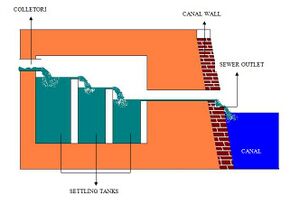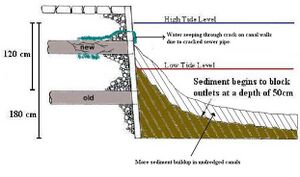Sedimentation
Over time sediment builds up in the canals of Venice. There are several different sources that contribute to the sediment in the canals including sewage, building debris, and material brought in naturally from the surrounding lagoon. If left unchecked, sedimentation in the inner canals can negatively affect the city.
Factors
There are three factors that contribute to sediment build up
Waste

There are several factors that contribute to the accumulation of sediment in the inner canals of Venice. Since the Canal also serves as the city’s Sewage System, a small amount of the sediment build up in the Canals comes from waste. Many houses are connected to collectors that help separate out the majority of the heavy solids prior to being deposited into the Canals.
Canal Wall Debris
Debris is another factor that makes up the canal’s sediment. The salt water from the Canals and Moto Ondoso erode the buildings over time and as pieces of the canal walls, as well as plaster from adjacent buildings fall apart they get deposited in the Canals.
Natural Silt
Silt from the lagoon is also brought in naturally from the tides. This natural movement of sediment contributes to the majority of the sediment build up.
Sediment Disposal
After Canal Maintenance is performed removed silt must be disposed of. The process of extracted sediment disposal is not a simple process. The sediment is usually taken to a chemical treatment plant where it is tested and classified. There are three classifications which mean one of three things: the sediment can be used as fertilizer, the sediment must be treated then used as fertilizer, or the sediment is unusable and must be sealed off and buried.
Sediment Research
In 1999 a study attempted to quantify the amount of sediment in the inner canals of Venice. The amount of sewage entering the canals was estimated by observing water consumption rates and determining how many sewer active to release waste water into the canals. They also observed the natural deterioration of plaster and used several different models of deterioration to determine an estimate of plaster debris that contributes to the sediment.
They determined that 11 percent of the sediment in the canals comes from sewage discharge and another 6 percent comes from masonry debris. The remaining 83 came from unknown sources.[1]
Potential Problems

In unchecked, sediment can build up in the canals and cause several problems. Canal depths can become so shallow at low tides that they became impassible. High sediment levels can also lead to increased rates of infrastructure damage. If the sediment blocks sewer outlets it can cause them to burst. Bursting sewer outlets can case rapid building erosion. Water seeps into the buildings foundation and erodes it from the inside out causing sever infrastructure damage. If the sediment levels rise significantly enough they can negatively affect the odor of the canals.[1]
Canal Maintenance
Since the Canals periodically fill up with sediment a regular Maintenance regime is necessary. Whenever the sediment became too high the Canals were typically sectioned off and drained so that the buildup of sediment could be removed.
External Links
http://gordonlibrary.wpi.edu/vwebv/holdingsInfo?searchId=586&recCount=10&recPointer=3&bibId=252377